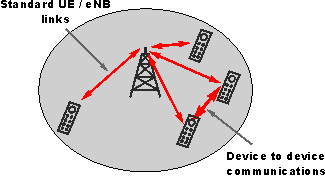4G LTE Device to Device, D2D
4G LTE Advanced device to device, D2D is a direct mode of communication whereby individual devices can communicate directly between them.
4G LTE includes:
What is LTE
LTE OFDMA / SCFDMA
MIMO
LTE Duplex
LTE frame & subframe
LTE data channels
LTE frequency bands
LTE EARFCN
UE categories / classes
LTE-M (Machine to Machine)
LTE-LAA / LTE-U
VoLTE
SRVCC
LTE Advanced topics:
LTE Advanced introduction
Carrier aggregation
Coordinated multipoint
LTE relay
Device to device, D2D
4G LTE device to device, D2D communications is a mode mainly intended for emergency services and other similar applications tat allows two LTE devices to communicate directly with each other without the need for a base station.
A number of applications could use this, but one of the earliest examples was for emergency services where they would be able to use their phones to communicate even without cellular coverage. This might be useful if they are outside normal coverage, for use within buildings where coverage is limited, or where the normal network is not usable.
LTE D2D communications is a peer to peer communications link which does not use the cellular network infrastructure, but enables LTE based devices to communicate directly with one another when they are in close proximity.
Benefits of D2D communications
Direct communications between devices can provide several benefits to users in various applications where the devices are in close proximity:
- Data rates: Devices may be remote from cellular infrastructure and may therefore not be able to support high data rate transmission that may be required
- Reliable communications: LTE Device to Device can be sued to communicate locally between devices to provide high reliability communications especially if the LTE network has failed for any reason - even as a result of the disaster.
- Instant communications: As the D2D communications does not rely on the network infrastructure the devices could be used for instant communications between a set number of devices in the same way that walkie-talkies are used. This is particularly applicable to t e way communications may be used by the emergency services.
- Use of licensed spectrum: Unlike other deveice to device systems including Wi-Fi, Bluetooth, etc, LTE would use licensed spectrum and this would enable the frequencies to be used to be less subject to interference, thereby allowing more reliable communications.
- Interference reduction: By not having to communicate directly with a base station, fewer links are required (i.e. essentially only between devices) and this has an impact of the amount of data being transmitted within a given spectrum allocation. This reduces the overall level of interference.
- Power saving : Using device to device communication provides energy saving for a variety of reasons. One major area is that if the two0 devices are in close proximity then lower transmission power levels are required.
LTE D2D basics
4G LTE device to device, D2D would enable the direct link of a device, user equipment UE, etc to another device using the cellular spectrum. This could allow large volumes of media or other data to be transferred from one device to another over short distances and using a direct connection.. This form of device to device transfer would enable the data to be transferred without the need to run it via the cellular network itself, thereby avoiding problems with overloading the network.
Other examples of direct communication include Wi-Fi Direct, Bluetooth, etc. Networks can be formed in many ways.

The D2D system would operate in a manner where devices within a locality would be able to provide direct communications rather than transmitting via the network. The cellular infrastructure, if present, may assist with issues like peer discovery, synchronisation, and the provision of identity and security information.
LTE D2D issues
The addition of the LTE D2D or device to device communication capability impacts the whole of the network and is therefore not a trivial addition, Issues like authorisation and authentication are currently handled by the network and the overall LTE system would need to be extended to accommodate device to device to communication without the essential presence of the network.
Another issue would be that of direct communication between devices that are under subscriptions with different operators, although this is unlikely to occur in the event of public service or emergency services.
With increasing numbers of emergency services using the existing cellular network to provide much better coverage and better cost efficiency than a separate network for them might, they and other services will need additional services and facilities. LTE D2D is one that is ideal for them, along with a number of other users.
 Written by Ian Poole .
Written by Ian Poole .
Experienced electronics engineer and author.
Wireless & Wired Connectivity Topics:
Mobile Communications basics
2G GSM
3G UMTS
4G LTE
5G
Wi-Fi
Bluetooth
IEEE 802.15.4
DECT cordless phones
Networking fundamentals
What is the Cloud
Ethernet
Serial data
USB
LoRa
VoIP
SDN
NFV
SD-WAN
Return to Wireless & Wired Connectivity


